

Pinterest. Costume Design vs. Character Design. I'll start this post by saying that I am not a costume or clothing designer.
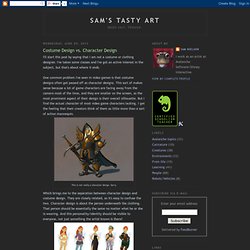
I've taken some classes and I've got an active interest in the subject, but that's about where it ends. One common problem I've seen in video games is that costume designs often get passed off as character designs. This sort of makes sense because a lot of game characters are facing away from the camera most of the time, and they are smaller on the screen, so the most prominent aspect of their design is their overall silhouette. But I find the actual character of most video game characters lacking. I get the feeling that their creators think of them as little more than a sort of action mannequin. Character Design: Big Shapes Vs. Small Details « Skullgirls. May 9th, 2011 Written By: Alex Ahad Hey guys, this is Alex Ahad, creative lead on Skullgirls.
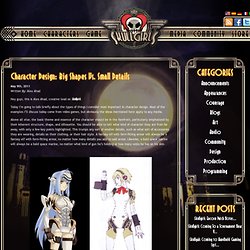
Today I’m going to talk briefly about the types of things I consider most important in character design. Most of the examples I’ll discuss today come from video games, but obviously the ideas mentioned here apply to any media. Above all else, the basic theme and essence of the character should be in the forefront, particularly emphasized by their inherent structure, shape, and silhouette.
You should be able to tell what kind of character they are from far away, with only a few key points highlighted. Catalogue of Curiosities. This post comes via Mark Christiansen’s blog as well as Yowp (both blogs are inexhaustible resources of 50s-60s era Hanna-Barbera).
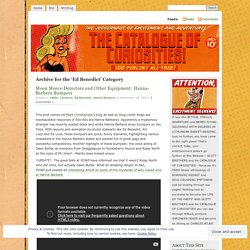
Apparently a mysterious stranger has recently posted black and white Hanna-Barbera show bumpers on You Tube. With layouts and animation by studio stalwarts like Ed Benedict, Art Lozzi and Ed Love, these bumpers are quick, funny scenarios, highlighting various characters in the Hanna-Barbera stable and packed full of great gags and wonderful compositions. Another highlight of these bumpers: the voice acting of Daws Butler, as everyone from Snagglepuss to Huckleberry Hound and Rojay North as the voice of Mr.
תמונת פרופיל – אולג מילשטיין : הפנקס – כתב עת מקוון לתרבות וספרות לילדים. Artist Interviews. Art Direction For Character Designers - New Demo. Color Theory Tutorial - How to colorize a character. Character Design: Thumbnailing - Thorin Oakenshield from The Hobbit. Does Everybody Want To Be A Character Designer? A young cartoonist asked me to critique her work: Hello Mr.

Kricfalusi, now after reading recently your posts from your blog (specially the parts where you comment about how old cartoons turned to what they are now, conservative, bland, etc.) they really called my attention-- it's something I usually don't hear. Therefore, that's why you're perfect for criticisms that I usually won't hear- for my drawings.
So far people are saying to me "Great drawing! " What I want is to hear at once is a different opinion, a new perspective about my drawings. I'd be really grateful if you could take your time to answer this message. Contrast and Variety. I often talk about how creating distinct and interesting characters with unique personalities is one of the most important parts of our trade.
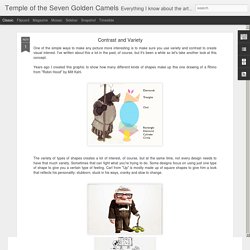
I'm warning you now, this is another one of those posts! Raymond Chandler was a writer of detective novels and the creator of the iconic hard boiled detective Philip Marlowe. Towards the end of his career, he sat down for an interview with Ian Fleming, the writer of the James Bond novels. If you Google something like "Raymond Chandler Ian Fleming interviews", you'll be able to find transcriptions and youtube excerpts so you can read it, or listen to it, or both. The entire thing is in a SoundCloud file that can be heard here. Here's the passage that I thought was the most interesting and relevant to this particular topic: Good Character Design Goes Deep. Tips on Character and Costume Design by Aaron Diaz. Character design is paramount to pretty much any kind of comic.

Most comics have things in them, and some of those things are characters, and those characters better be well-designed. Design allows the artist to communicate essential information to the reader about a character, and a good design allows for versatility independent of minor details. Character Design with Len Simon Part 1. Character Designers: Creating identities. The SPA Studios. Character Design Tips from Sergio Pablos. (134) Sketch Studies (KarrtoonStudies) on Pinterest. Character Design for Animation with Nate Wragg. (134) Character Design. (134) character design on Pinterest. My 7 steps to great Character Design.
Character Design References (characterdesigh) Costume Design: The Hidden Layer of Movie Magic. Art of Olivia Margraf-Posta. The Street Vibe (@thestreetvibe) Cuphead's Animation Process and Philosophy. BEGINNERS CHARACTER DESIGN. OSF Costume Rentals. Need assistance designing your show? Custom costume plots and show packages are available! Contact us for more information: costumerentals@osfashland.org or 541-482-2111 x308 The Pirates of Penzance 2011 - Amber Harris, Kimbre Lancaster, Kate Hurster, Emily Sophia Knapp, Mandie Jenson Photo by T.Charles Erickson. Making of “The Reward” (1) Character Design For Animation - Nate Wragg - New Demo. Truebluemeandyou: Guide to Back Yokes and... - Helpful Harrie. An Art Tip Jar. Screen style & identity.
Tips on Character and Costume Design by Aaron Diaz. Character Design with Personality: 4 Core Concepts for Creating Better Characters. Tips on Character and Costume Design by Aaron Diaz. The Art Resource. Anonymous said: can you give me some tips on how to draw teeth ?
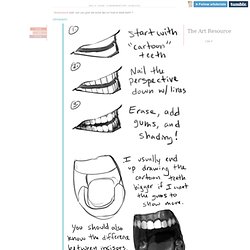
Cyborgraptor: ashbet: *wry laugh* Unless you have Ehlers-Danlos Syndrome — my daughter and I both winced/chuckled at that remark about the fingers “not being able to bend back too far.* Hers can almost touch the backs of her hands, because they bend backward to that degree. (With that said, it’s an excellent tutorial on normal-human-being hands, for people who aren’t absurdly hypermobile!)
Dota2CharacterArtGuide.pdf. Animation news + art — 10 Helpful Notes On Character Design. Artist Interviews. Make Movies - Characters page 4. To make a character work well it has to be the right character for the part.
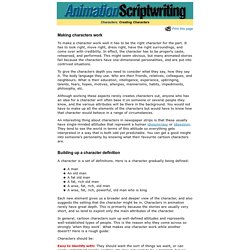
It has to look right, move right, dress right, have the right surroundings, and come over with credibility. In effect, the character has to be properly caste, rehearsed, and performed. This might seem obvious, but many animated stories fail because the characters have one-dimensional personalities, and are put into contrived situations. To give the characters depth you need to consider what they say, how they say it. The body language they use. Although working these aspects rarely creates characters out, anyone who has an idea for a character will often base it on someone or several people they know, and the various attributes will be there in the background. An interesting thing about characters in newspaper strips is that these usually have single-minded attitudes that represent a human idiosyncrasy or obsession.
Make Movies. John K Stuff: New Character Design Blog. JohnKDesign. John K Stuff: Incidental Character Designs By Post. As has been pointed out and acknowledged, Warren Kremer created the Harvey comics house style that the other cartoonists followed.
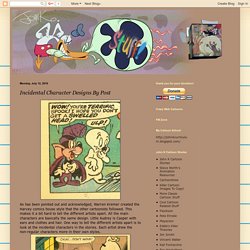
This makes it a bit hard to tell the different artists apart. All the main characters are basically the same design. Little Audrey is Casper with ears and clothes and hair. One way to tell the different artists apart is to look at the incidental characters in the stories. Each artist drew the non-regular characters more in their own styles. Spooky is a generic Harvey character, but the ghost next to him is a very specific design. Howie Posts's incidental characters are generally more specific and cartoony than the other cartoonists at Harvey. They are also cuter; they have big heads in proportion to their bodies. This cover is likey by Warren Kremer. Here is a stark contrast between the Howie Post comic on the left and the other artist on the right. John K Stuff: Does Everybody Want To Be A Character Designer? Clothes on Film. Into the Woods opened on Broadway in 1987, with the music and lyrics written by Stephen Sondheim and the book by James Lapine.

It is Sondheim’s most performed musical and one of his best known works. The story combines familiar characters from childhood fairy tales such as Cinderella, Little Red Riding Hood, and the ubiquitous Witch, and explores their journeys to get their wish, as well as the negative consequences of the small dishonesties committed by each character to get what they want. As the witch sings, “Told a little lie/Stole a little gold/Broke a little vow/Did you? /Had to get your prince/Had to get your cow/Had to get your wish/Doesn’t matter how.” As the story unfolds, the traditional dichotomies of good and evil, and our expectations of each character, are shaken. Force Character Design From Life Drawing by Vichanum Vimunjit. A Humble Professor. PIXAR - Home. It Means Rey AND Luke AND Finn, Y'All — Every woman in every Disney/Pixar movie in the...
WATCH: Ed Hooks Talks Good and Bad Acting in Animation at FMX 2015. The 3 Key Psychological Hooks to Creating Compelling Characters. What does the writing behind film's most successful characters have in common? While artificial intelligence has been busy identifying the most successful story arcs in film, I’ve been focused on the one thing that algorithms will never understand: human characters. In particular, I’ve found three ubiquitous yet distinguishing features that all compelling characters share in successful screenplays and films.
What makes these three characteristics so significant is the psychological effects that they have on an audience, as well as their functional effects on story. In short, all three characteristics contain a universal principle that resonates with us as individual characters ourselves. Distinction is the unconscious prompt that draws us into a character’s world. 1. Distinction is whatever makes your character different and unique to the audience. This psychology also plays out with respect to the characters in our screenplays. Or take Steve Carell’s character in The 40-Year-Old Virgin. Character Animation. The 3 Key Psychological Hooks to Creating Compelling Characters. Character Animation. Laughing Matters Pt 1. Tim's Animation Mentor Blog. I’ve always been interested in methods of learning, whether it be animation, language or any other topic. In the creative fields a musician will start by playing popular music, a writer will read profusely and a painter will spend some time copying masters.
With modern CG animation schools and their relatively short course lengths it seems that idea of really analysing and copying masters as a way to learn the craft is often sacrificed. Tim's Animation Mentor Blog. Currently working on a new acting shot for my reel, so while in the planning frame of mind I thought I’d make a post out of some tips I’ve gathered and now use as part of my workflow. 1.
Searching for Audio ClipsAnimation Mentor discourages audio clip web sites and I personally tend to agree with them. Find unique clips with decent audio quality. TV shows can be a reliable source, if you can think of a character you like then there will be plethora of lines if the show has run through a few seasons. Some things to look for in clips: – A story. You can also make the audio clip work better for you. Gestures and Body Language 2. The SPA Studios. Character Design Tips from Sergio Pablos.
Good Character Design Goes Deep. John K Stuff: Character Design 1: The Character Design Fallacy. First of all, character design should never have been separated from the rest of the animation process. The handful of artists from classic cartoons that are renowned for their character designs, were not really character designers at all. They were layout artists. Layout artists who who were also animators. When they finally got around to designing characters, they knew the functional needs of the job - and they usually layed out the cartoons. Skillshare. Character Design. Character Design Tutorial by Drew Hill.
Character design for animation on Behance. Dota2CharacterArtGuide. CharacterDesign. Force Character Design From Life Drawing by Vichanum Vimunjit. Fundamentals of Character Design Class with David Colman. Art Direction For Character Designers. Art and Reference point. The other day I came across this awesome program by accident (I don’t even remember what I was actually searching for, but on the several times I’ve looked for a program like this I’ve had no luck). It’s cool enough that I wanted to share it. It’s called DesignDoll (website here) and it’s a program that lets you shape and pose a human figure pretty much however you want.There’s a trial version with no expiration date that can be downloaded for free, as well as the “pro license” version priced at $79.
I’ve only had the free version for two days so far, so I’m not an expert and I haven’t figured out all of the features yet, but I’ve got the basics down. The website’s tutorials are actually pretty helpful for the basics, as well. Here’s the page for download, which has a list of the features available in both versions. And to make it a bit more convenient, there’s a library of pre-set hand poses you can pick from as well, and then change the pose from that if you like. Amanda Elsbree (amandaelsbree) on Pinterest. THE ART CENTER / Sharing Ideas And Tips From Artist To Artist. Make Movies.